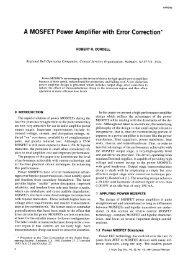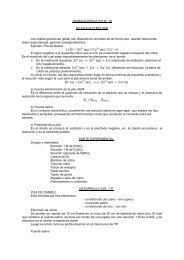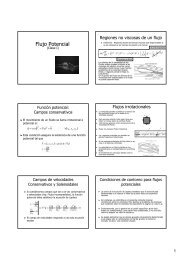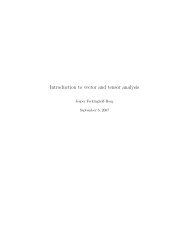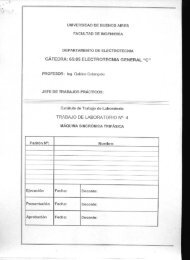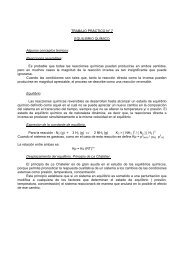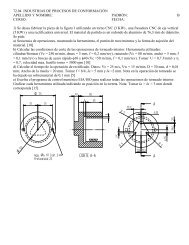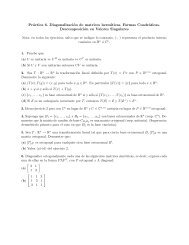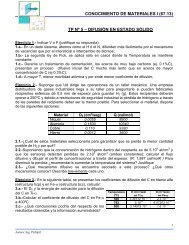Download PDF
Download PDF
Download PDF
You also want an ePaper? Increase the reach of your titles
YUMPU automatically turns print PDFs into web optimized ePapers that Google loves.
Ahlbom<br />
Table 5. Certain characteristics and findings of studies on the relation between EMF exposure and Alzheimer’s disease.<br />
Definition and Study Resulting RR<br />
Reference Study population and subject identification estimation of exposure design Numbers (95% CI)<br />
Sobel et al., 1995 Study population: not specified. Cases: three sets Interview data on primary CC 386 cases (36 exposed) 3.0<br />
(161) of AD patients examined, 77–93 years of age, at one occupation. Classification into 475 controls (16 exposed) (1.6–5.4)<br />
neurologic clinic in the U.S. and two in Finland. Controls: high/medium vs low EMF<br />
three sets—vascular dementia patients, patients<br />
exposure<br />
without neurologic disease, and neighborhood controls.<br />
Sobel et al., 1996 (168) Study population not specified. Cases: patients with Statewide data form information CC 326 cases 3.9<br />
probable or definite AD treated at AD medical center on primary occupation. Classification 152 controls (1.5–10.6)<br />
in California, USA. Controls: patients who were<br />
into high/medium vs low EMF<br />
cognitively impaired or demented<br />
exposure<br />
Feychting et al., 1998 Study population: subsample of the Swedish Twin Interviews. Primary and last CC 55 cases 0.9 (primary)<br />
(163) Registry. Cases: identified through a screening and occupation. Classification into 228 and 238 controls (0.3–2.8)<br />
evaluation procedure. Controls: intact twins with one three levels, based on JEM, (similar with<br />
twin in each of two control groups when two twins highest >0.2 µT other control<br />
were eligible<br />
group)<br />
Savitz et al., 1998 (158) Male population in 25 U.S. states, 1985–1991. Job title on death certificate: CC 256 cases in electrical 1.2<br />
Cases: deaths from AD. Controls: deaths from other electrical occupation in aggregate occupations, in aggregate (1.0–1.4)<br />
causes<br />
and individual jobs<br />
Savitz et al., 1998 (159) Male employees at five U.S. utility companies, 1950– Measurements and employment Cohort 16 cases with >20 years in 1.4<br />
1988. Cases: deaths with AD mentioned on death records. Combination of duration exposed occupations (0.7–3.1)<br />
certificate identified from multiple tracking sources and EMF index<br />
Abbreviations: JEM, job exposure matrix.<br />
Thus, the two utility worker studies<br />
combined provide relatively strong evidence<br />
that work with EMF exposure in the utility<br />
industry is indeed related to increased ALS<br />
mortality (Table 4). This result is reinforced<br />
by the results of the other studies on ALS discussed<br />
above, even though the five other<br />
studies have to be given less weight.<br />
Alzheimer’s disease. Five studies on AD<br />
were found (158,159,161–163) (Table 5).<br />
The first two studies shown in Table 5<br />
were clinic-based, case–control studies. The<br />
first combined three series of AD patients,<br />
one from the United States and two from<br />
Finland (161). These series came from neurological<br />
centers that specialized in diagnosis<br />
and treatment of AD and can therefore be<br />
assumed to be based on high-quality diagnoses.<br />
For one series of AD patients vascular<br />
dementia patients were used as controls; for<br />
the second series, controls were other patients<br />
without neurological disease, and for the<br />
third, neighborhood controls. The second<br />
study comes partly from the same group of<br />
investigators and was an attempt to confirm<br />
the findings from their first publication<br />
(162). It was also based on patients from a<br />
specialized clinic in the United States and<br />
used another group of patients as controls.<br />
Both studies based exposure classification on<br />
jobs as reported by the patient or a relative.<br />
The major weakness is the lack of a specified<br />
study population and thus the potential for<br />
selection bias.<br />
Of the three remaining AD studies, one<br />
was based on the Swedish Twin Registry. The<br />
investigators evaluated twins included in the<br />
registry, which was set up for the purpose of<br />
conducting genetic studies of dementia in<br />
twins (163). Exposure to EMF was assessed<br />
through interviews that included job history.<br />
Diagnostic quality in the study was good, as<br />
was the detail in which EMF exposure was<br />
assessed. Another strength was the defined<br />
population base for the study. The main problem<br />
with this study was its small size, as<br />
reflected by the relatively wide confidence<br />
intervals. It also had a contradiction in its<br />
findings depending on whether primary or last<br />
occupation was used as the basis for analysis.<br />
The last two studies were discussed in the<br />
ALS section above, because they provide data<br />
on both diseases (Table 5). These are the<br />
death certificate study and the utility worker<br />
study, both in the United States (158,159).<br />
As discussed in the ALS section, these are<br />
both reliable studies, but the death certificate<br />
study used a crude measure for the EMF<br />
exposure assessment. The utility worker study<br />
is less suited for AD because of the limited<br />
usefulness of death certificate as a source of<br />
disease classifications. However, the investigators<br />
report results both for underlying causes<br />
of mortality and for contributing causes, and<br />
there is a difference between those results.<br />
When contributing causes are used, there is<br />
little support for an association between EMF<br />
and AD, while the use of underlying cause<br />
gives some support for such an association.<br />
Because of the nature of this disease, it seems<br />
more logical to look at contributing causes.<br />
Interpretation. Even if the studies on<br />
ALS consistently suggest an increased risk in<br />
EMF-exposed subjects, one would like confirmatory<br />
results from additional studies, in<br />
studies specifically designed for the purpose.<br />
Assuming that the observed risk elevation is<br />
accurate, it still remains to be explained.<br />
Aside from the hypothesis that EMF exposure<br />
increases ALS risk, one must consider<br />
alternative explanations. One such alternative<br />
would be confounding from electric shock<br />
exposure. It is conceivable that exposure to<br />
electric shocks increases ALS risk and, also,<br />
that work in the utility industry carries a risk<br />
of experiencing electric shocks. Some of the<br />
reviewed studies did report analyses that<br />
indeed linked electric shocks to ALS<br />
(154,156,160), but none of the studies provided<br />
an analysis in which the relation<br />
between EMF and ALS was studied with control<br />
for electric shocks. A crude calculation<br />
can be made from data provided by Deapen<br />
and Hendersen (154), and this seems to indicate<br />
that the EMF association holds up even<br />
after control for electric shock experience.<br />
As for AD, when evaluated across all the<br />
studies, there appears to be an association<br />
between estimated EMF exposure and disease<br />
risk (Table 6). However, this result is mainly<br />
confined to the first two studies in the United<br />
States, and it is not clearly confirmed by the<br />
later studies (153,154,158,161,162). The two<br />
studies that show excess (161,162) may have<br />
been affected by selection bias. Because the<br />
study populations are undefined, there is no<br />
way to determine the extent to which the<br />
controls are representative with respect to<br />
exposure of the population from which the<br />
cases originated.<br />
Conclusion. For reasons discussed in the<br />
preceding sections, the ALS results are<br />
intriguing and point toward a possible risk<br />
increase in subjects with EMF exposure.<br />
However, confirmatory studies are needed, as<br />
is an appropriate consideration of confounding,<br />
for example, from electric shocks, as a<br />
conceivable explanation. As for AD, it<br />
appears that the excess risk is constrained to<br />
studies with weaker designs; thus support for<br />
926 VOLUME 109 | SUPPLEMENT 6 | December 2001 • Environmental Health Perspectives



